Monthly economic brief: March 2021
Summary of latest key economic statistics, forecasts and analysis on the Scottish economy.
Consumption
Consumer sentiment and consumption activity have been significantly impacted by the coronavirus pandemic and restrictions on activity, however there are signs that sentiment has strengthened at the start of 2021.
Consumer sentiment
- In Q4 2020, the Scottish Consumer Sentiment Indicator was -21.5 and decreased by 2.7 points compared to Q3 2020. This indicates that consumer sentiment weakened over the quarter, and is at its lowest point in the time series.
- Underlying the composite indicator, the current sentiment indicators for the economy, household financial security and attitude to spending all fell to their lowest levels in the times series, reflecting the ongoing impacts of the pandemic on households current circumstances, when compared to the previous year.
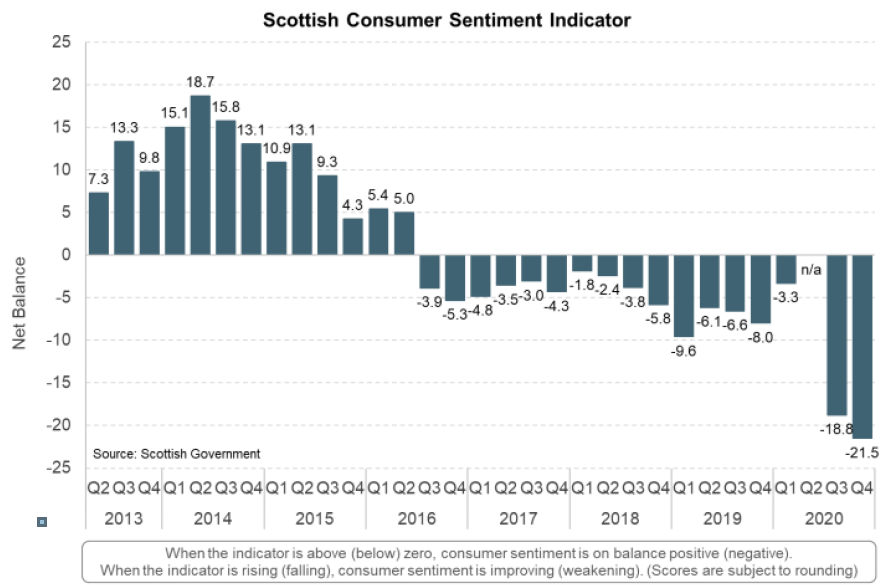
- Looking ahead, households continue to expect the economy and their household financial security to improve over the year (relative to the current situation). However, the largest falls between the third and fourth quarters of the year were in the expectations indicators for the next 12 months, signalling that the level of optimisim weakened over the quarter.
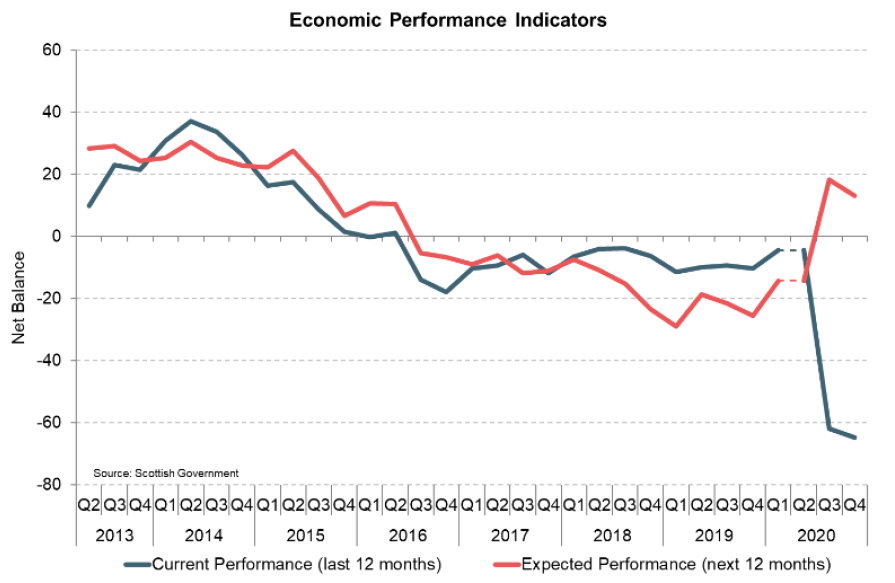
- The underlying monthly data for the fourth quarter does however suggest that optimsim strengthened over November and December relative to October, suggesting that consumer sentiment was likely sensitive to a combination of expectations regarding the tightening of restrictions over this period alongside developments in the vaccination rollout and their implications for the economic recovery.[18]
- More recent GfK UK consumer sentiment data[19] for February showed that while consumer sentiment remained low compared to pre-pandemic levels, it increased to its highest level since March 2020, driven by improved expectations for the economy over the next 12 months. This again potentially reflects the roll out of the vaccination programme and expectations of further economic recovery.
- Sentiment indicators have been highly sensitive to the rapidly moving developments on the pandemic over the past year and will likely be a key factor influencing the pace at which consumption recovers as restrictions are lifted.
Retail sales
- The Scottish Retail Sales Monitor for February[20] reported a further sharp fall in the value of retail sales during current lockdown restrictions compared to the previous year, though to a slightly lesser extent than in January.
- Total sales in February were down 24.3% year on year in Scotland, down slightly from the 27.9% fall in January.
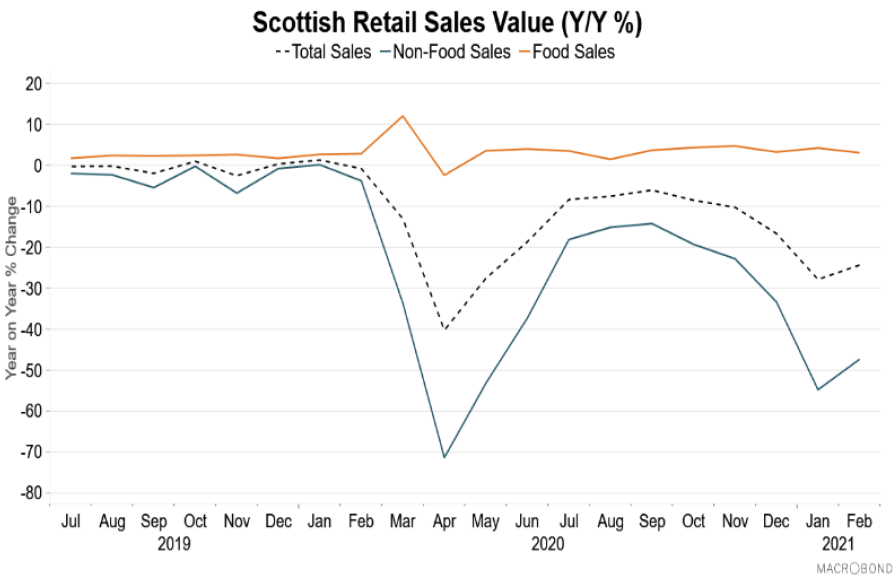
- This was driven by a 47.4% fall over the year in non-food sales, which is reflective of the current lockdown restrictions, while food sales were up 3.1% compared to last year and remain relatively stable.
Household Savings and Consumer Credit
- At an aggregate level, household savings have increased significantly during the pandemic, as restrictions have caused expenditure to fall while support schemes have helped protect household incomes.
- It is important to note that this has not been the case across the whole economy. In particular, lower income households have faced more significant financial challenges.
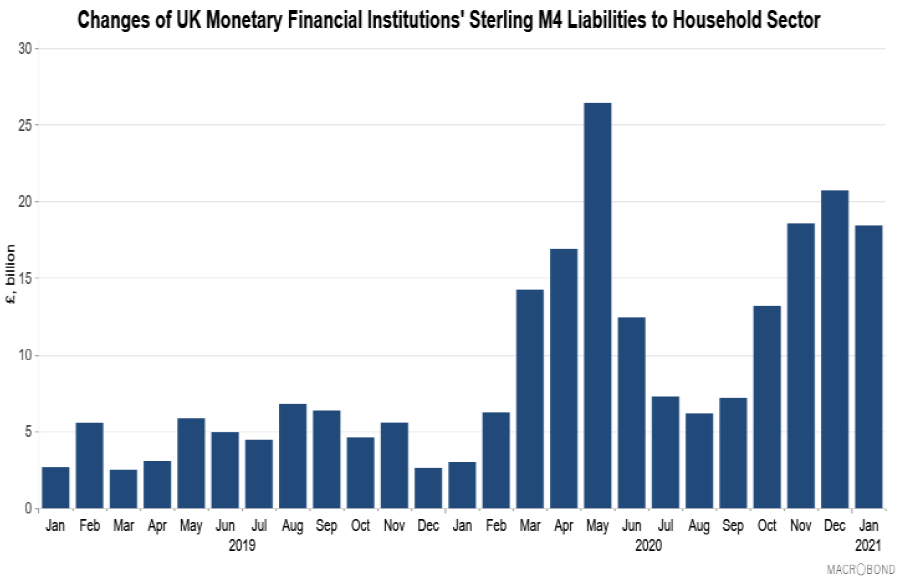
- Bank of England data show the net flows from households into deposit-like accounts was £18.5 billion in January and remains notably higher than the monthly average of £4.8 billion in the six months to February 2020.[21] Since February 2020, these savings have increased by £162 billion (around 7% of GDP).
- Alongside this, between March and June 2020 and between September 2020 and January 2021 households on aggregate repaid more consumer credit than they took on in new borrowing.
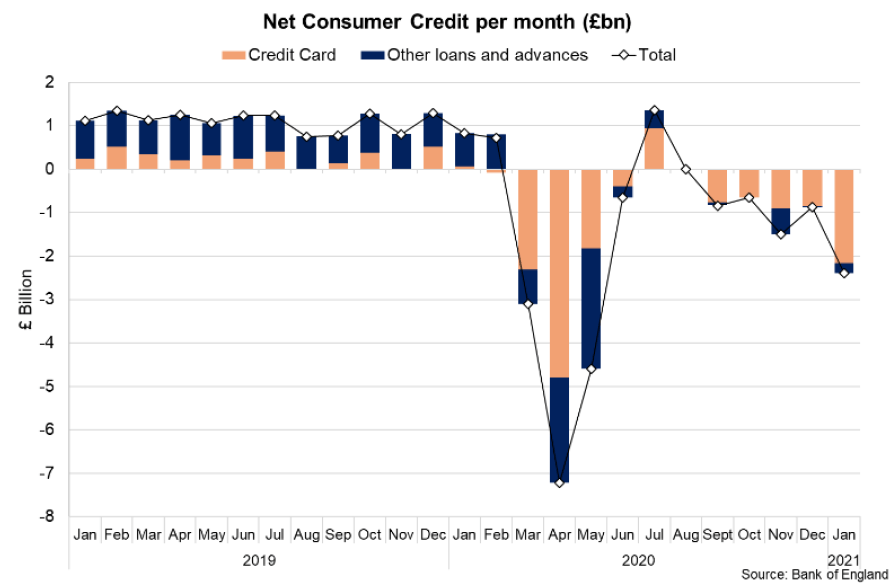
- Latest data for January 2021, show households made net repayments of £2.4 billion on consumer credit, with net repayments gradually rising from September 2020 and reflective of the current weakness in consumption.
- Overall, the extent to which households subsequently spend accumulated savings as restrictions ease remains uncertain, however Bank of England and OBR forecasts assume that around 5% of the additional savings will ultimately be spent.
The Global Open Finance Centre of Excellence Citizen's Project
Since early 2020, the Office of the Economic Adviser and the Covid-19 Data & Intelligence Network[22] have been supporting a partnership between NatWest Group and the Global Open Finance Centre of Excellence (GOFCoE), hosted at the University of Edinburgh, to explore the potential to use banking data to provide real time insight into the impacts on household finances of Covid-19. This is one example of the way GOFCoE is seeking to safely unlock the potential of customer data to improve lives and inform public policy and research.
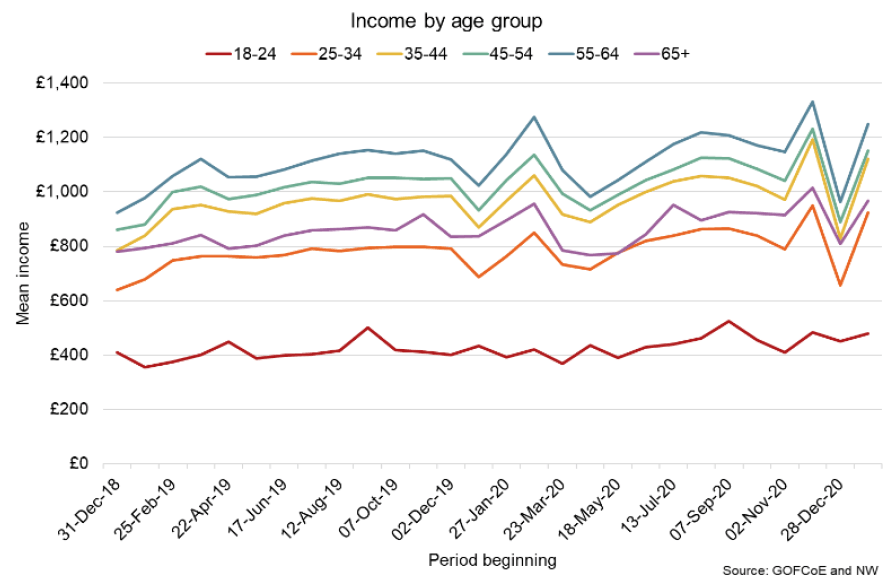
This has led to the development of the Citizens' data project, which uses pseudo-anonymised data from a random sample of 1 million customer current accounts. Pseudo-anonymization makes the data non-attributable to any customer as transaction data is fully categorised and broadly aggregated by NatWest Group (NWG) before being transferred to a secure data environment for further processing at GOFCoE. GOFCoE researchers undertake further analysis of the anonymised data, and are able to share insights based on further aggregations of the data with government and other stakeholders, who are bound by information sharing agreements.[23]
The collaboration began delivering proof of concept results in autumn 2020, and has now progressed to delivering a broad range of outputs. The project is expected to be able to deliver regular updates on household finances from April 2021.
The Citizen's project allows us to monitor weekly changes in household finances since January 2019. This helps provide evidence of the impact that the pandemic has had on both household incomes and expenditures, and how this has changed following the first national lockdown, the easing of restrictions over the summer, and then the gradual reintroduction of tighter restrictions from autumn onwards. As illustrated in the graphs, there is the potential to analyse changes by broad demographic indicators, such as age and gender, as well as on a regional basis across the UK.
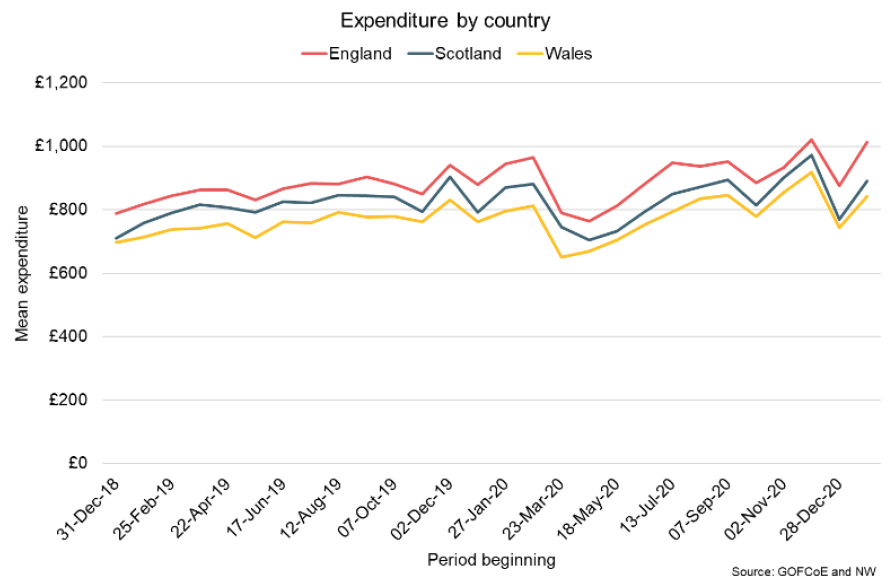
As well as insights into household finances, work is continuing between GOFCoE and NatWest Group to develop insights into business finances, particularly small and medium sized businesses (SMEs).
The Citizens project remains in development, but has already begun to offer new insights into household finances, both in Scotland and across the UK. Further work will include engagement with the public to understand their views of the work and its applications.
Interest rate and inflation
- The Consumer Prices Index including owner occupiers' housing costs (CPIH) 12-month inflation rate increased to 0.9% in January, up from 0.8% in December and up from its recent low of 0.5% in August 2020.[24]
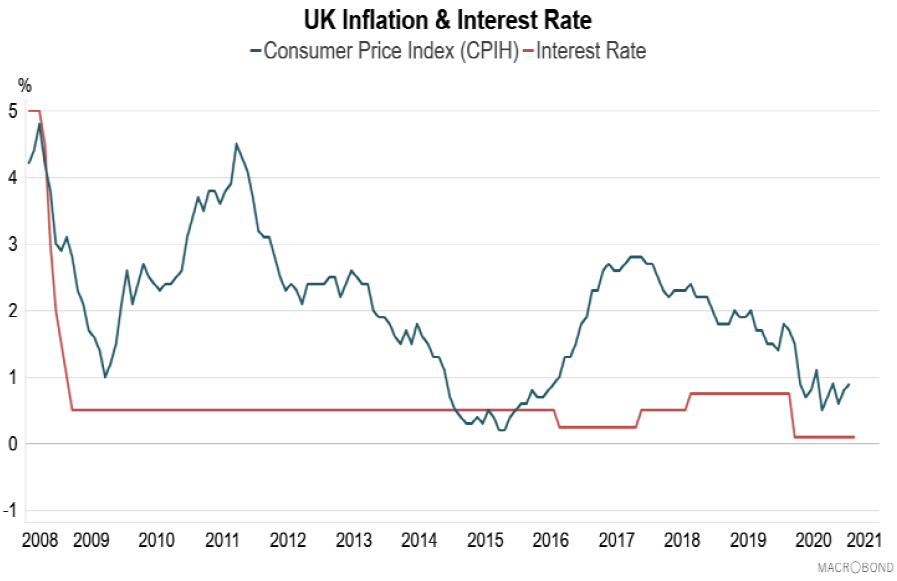
- There were key upward contributions to the inflation rate from recreation and culture, furniture and household goods, which offset downward effects from falling clothing and footwear prices.
- The Bank of England maintained the Bank Rate at 0.1% in March 2021[25] and in their current central scenario analysis project inflation to rise to around 2% in 2021.[26]
GDP growth outlook
The economic outlook remains extremely challenging. GDP is forecast to fall in the short term reflecting current lockdown restrictions before growing over 2021 as the economy reopens.
| 2021 | 2022 | 2023 | 2024 | 2025 | |
|---|---|---|---|---|---|
| SFC (Scotland) | 1.8 | 7.5 | 1.6 | 1.6 | 1.7 |
| OBR (UK) | 4.0 | 7.3 | 1.7 | 1.6 | 1.7 |
- In Scotland, the Scottish Fiscal Commission[27] forecast Scottish GDP to fall by 5.2% in the first quarter of this year, reflecting the tightening of restrictions, while unemployment is projected to rise to 7.6% in the second quarter, following the scheduled end of the furlough scheme.
- Longer term the SFC forecast modest growth of 1.8% over 2021 as a whole, as health restrictions are assumed to persist throughout the year, before accelerating to 7.5% growth in 2022, as restrictions are assumed to no longer be required. Scotland's GDP is expected to return to pre-pandemic levels at the start of 2024.
- In their latest growth scenario analysis published in March, the Fraser of Allander Institute's central scenario projects Scotland's GDP to grow 3.6% in 2021 and 5.6% in 2022, with GDP returning to pre-crisis levels in October 2022.[28] However, the level of ongoing uncertainty is reflected in their more pessimistic scenario of 2.4% growth in 2021 (GDP recovers to pre-crisis levels later in July 2023) and their more optimistic scenario of 4.2% growth in 2021 (GDP recovers to pre-crisis levels earlier in June 2022).
- At a UK level, and in their forecasts for the UK Budget, the Office for Budget Responsibility[29] projects UK GDP to fall 3.8% in the first quarter of 2021 reflecting the current restrictions on activity. Over 2021 as a whole, UK GDP is forecast to grow 4% reflecting the rollout of the vaccination programme and easing of restrictions and return to pre-crisis levels in Q2 2022. Unemployment is expected to peak at 6.5% at the end of 2021 – around 2.2 million individuals.
- The latest average of new independent UK forecasts published by HM Treasury[30] suggests UK GDP is expected to grow 4.8% in 2021. The average new forecast for 2021 has improved slightly from February (up 0.5 percentage points) potentially reflecting the latest plans to ease restrictions and optimism around the speed and efficacy of the rollout of vaccines.
- At a global level, world GDP is estimated to have fallen 3.4% in 2020, however the OECD forecast growth of 5.5% in 2021 and 4% in 2022, with global output rising above the pre-pandemic level by mid-2021.[31]
- However, the OECD set out that while vaccination programmes and adaptation to restrictions have improved the global economic outlook in recent months, divergence across countries and sectors is emerging and output in many countries at the end of 2022 will remain below the levels expected prior to the pandemic.
Contact
Email: OCEABusiness@gov.scot
There is a problem
Thanks for your feedback